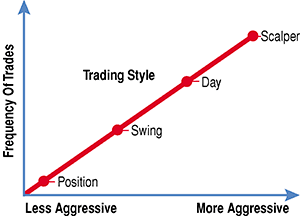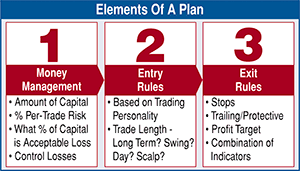trading techniques
Never Trade Without One
The Trading Plan
When creating a trading plan, you have to take into account all the possible contingencies. Here are the steps you should go through when designing your game plan.
A trading plan is your carefully thought-out and tested way of approaching and beating the market over the long term. It is the course of action for entering, exiting, and managing your trades so that all contingencies are considered before a trade ever takes place. With such a plan, emotions are left out of the trading equation, and only tangible criteria are used to make trades. Emotions can cause many problems in trading, including entering trades out of boredom, entering trades too early or not at all because of anxiety, staying in trades after profits should have been taken due to an emotional attachment to a tradable, or exiting too early and for a minuscule profit when it should have been left open longer.
The benefits
Having a trading plan will allow you to navigate different circumstances methodically and logically. This process can be repeated, tested, and then altered if results are not up to your standards. If you trade based on emotion, you will not be able to go through this process because your emotions will always get in the way and you will react accordingly. Problems can be avoided by not having to trade on reactions to the moment. The market is in constant flux, which in turn means emotions can be in constant flux. Well-laid-out trading plans will allow traders to avoid this barrage of emotion as they will know in advance how to handle each situation as it arises.
Designing a trading plan gives you ground rules by which to trade and a consistent basis for which your results can be compared using different trading criteria. If you lose money and you are still sticking to the plan, you will know it is your plan that needs to be worked on. If you donŐt have a plan, you have no real idea what is causing your losses, since they are not based on anything other than your thoughts and emotions at the time of the trade. Having a plan will save you time and money as you pursue consistent profitablility.

FIGURE 1: what kind of trader are you? Knowing the type of trader you are is a first important step in determining a Trading Plan.
On occasion, the markets do reward bad trades (or, at least, trades that have not been thought through). This is known as random reinforcement — believing you have a winning trading system when you do not. Due to the sheer number of transactions possible, some trades will randomly work out when no forethought was given to the trade at all. The true trader strives for consistency over the long term. It is essential to have a trading plan so that over the course of many trades you will be able to see if your success (or failure) is related to sheer, dumb luck.

FIGURE 2: three important steps The main elements of a basic Trading Plan.
In order to develop a trading plan, there are several steps that we should go through. The plan should not leave room for traders to question what to do during a trade. All possible questions must be looked at before trades are made, so that when money is on the line, traders will know that they can rely on their plan because it was well thought out and all pertinent questions were asked and scrutinized during the making of the plan.